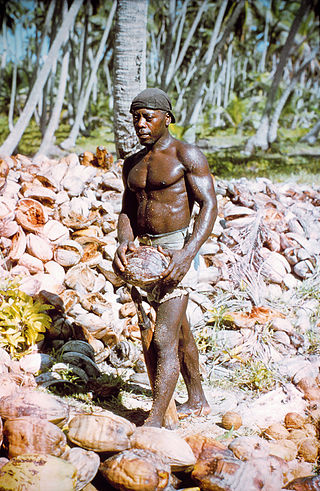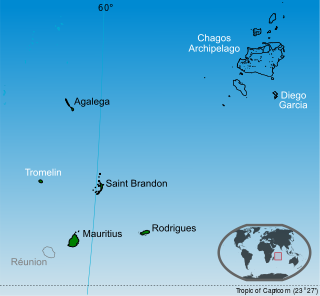
Diego Garcia is an island of the British Indian Ocean Territory, an overseas territory of the United Kingdom. It is a militarised atoll just south of the equator in the central Indian Ocean, and the largest of the 60 small islands of the Chagos Archipelago. The Portuguese were the first Europeans to find it and it was then settled by the French in the 1790s and transferred to British rule after the Napoleonic Wars. It was one of the "Dependencies" of the British Colony of Mauritius until the Chagos Islands were detached for inclusion in the newly created British Indian Ocean Territory (BIOT) in 1965.

The Chagos Archipelago or Chagos Islands is a group of seven atolls comprising more than 60 islands in the Indian Ocean about 500 kilometres (310 mi) south of the Maldives archipelago. This chain of islands is the southernmost archipelago of the Chagos–Laccadive Ridge, a long submarine mountain range in the Indian Ocean. In its north are the Salomon Islands, Nelson's Island and Peros Banhos; towards its south-west are the Three Brothers, Eagle, Egmont and Danger Island(s); southeast of these is Diego Garcia, by far the largest island. All are low-lying atolls, save for a few extremely small instances, set around lagoons.

The Chagossians are an African ethnic group originating from French slaves brought to the Chagos Islands, specifically Diego Garcia, Peros Banhos, and the Salomon island chain, in the late 18th century. Most Chagossians now live in Mauritius and the United Kingdom after being forcibly removed by the British government in the late 1960s and early 1970s so that Diego Garcia, the island where most Chagossians lived, could serve as the location for a United States military base. Today, no Chagossians are allowed to live on the island of Diego Garcia, as it is now the site of the military base dubbed Camp Thunder Cove.

Sir Bruce Greatbatch, was the British Governor of the Seychelles from 1969 to 1973.
The United Kingdom, at the request of the United States, began expelling the native inhabitants of the Chagos Archipelago in 1968, concluding its forced deportations on 27 April 1973 with the evacuation of Peros Banhos atoll. The inhabitants, known at the time as the Ilois, are today known as Chagos Islanders or Chagossians.

Naval Support Facility Diego Garcia is a British Ministry of Defence facility leased to the United States Navy, located on the atoll Diego Garcia in the Indian Ocean.
The UNROW Human Rights Impact Litigation Clinic is a student litigation and advocacy project at American University's Washington College of Law.

The British Indian Ocean Territory (BIOT) is an Overseas Territory of the United Kingdom situated in the Indian Ocean, halfway between Tanzania and Indonesia. The territory comprises the seven atolls of the Chagos Archipelago with over 1,000 individual islands – many very small – amounting to a total land area of 60 square kilometres. The largest and most southerly island is Diego Garcia, 27 square kilometres, the site of a Joint Military Facility of the United Kingdom and the United States.

R v Secretary of State for Foreign and Commonwealth Affairs, ex parte Bancoult [2008] UKHL 61 is a UK constitutional law case in the House of Lords concerning the removal of the Chagos Islanders and the exercise of the Royal Prerogative. The Chagos Islands, acquired by the United Kingdom in 1814, were reorganised as the British Indian Ocean Territory (BIOT) in 1965 for the purpose of removing its inhabitants. Under a 1971 Order in Council, the Chagossians were forcibly removed, and the central island of Diego Garcia leased to the United States for use as a military outpost.

Sovereignty over the Chagos Archipelago is disputed between Mauritius and the United Kingdom. Mauritius has repeatedly stated that the Chagos Archipelago is part of its territory and that the United Kingdom claim is a violation of United Nations resolutions banning the dismemberment of colonial territories before independence. The UK government has stated that it has "no doubt" about its sovereignty over the Chagos, yet has also said that the Chagos will be returned to Mauritius once the islands are no longer required for military purposes. Given the absence of any meaningful progress with the UK, Mauritius took up the matter at various legal and political forums. The African Union and the Non-Aligned Movement have expressed unanimous support for Mauritius.
The Chagos Marine Protected Area, located in the central Indian Ocean in the British Indian Ocean Territory of the United Kingdom, is one of the world's largest marine protected areas, and one of the largest protected areas of any type on Earth. It was established by the British government on 1 April 2010 as a massive, contiguous, no-take marine reserve, it encompasses 640,000 square kilometres (250,000 sq mi) of ocean waters, including roughly 70 small islands and seven atolls of the Chagos Archipelago.

Allen Vincatassin is a Chagossian activist who is the first and current President of the Diego Garcia and Chagos Islands Council. He was arrested and jailed in 2020 and 2021 for fraud.
Aurélie Marie-Lisette Talate, also known as Lisette Talate or Aurelie Talate in her community was a Chagossian activist and emblematic figure of the Chagossian struggle to regain their islands; which they were forcibly exiled from by the occupying US military with permission from the UK in order to establish the Diego Garcia military base. Despite strong desire from the community to return to their land, the US and UK governments have patently refused to allow right of return.

Overseas military bases of the United Kingdom enable the British Armed Forces to conduct expeditionary warfare and maintain a forward presence. Bases tend to be located in or near areas of strategic or diplomatic importance, often used for the build-up or resupply of military forces, as was seen during the 1982 Falklands War and the use of RAF Ascension Island as a staging post. Most of the bases are located on British Overseas Territories or former colonies which retain close diplomatic ties with the British government.
British Forces British Indian Ocean Territories (BFBIOT) is the name for the British Armed Forces Permanent Joint Operating Base (PJOB) on Diego Garcia, in the British Indian Ocean Territory. While the naval and airbase facilities on Diego Garcia are leased to the United States as Naval Support Facility Diego Garcia, in practice, the base operates as a joint UK-US base, with the United Kingdom retaining full and continual access.
Same-sex marriage in the British Indian Ocean Territory has been legal since 3 June 2014. An Order in Council to legalise same-sex marriages was enacted by the Privy Council of the United Kingdom on 28 April 2014, and took effect on 3 June. The British Indian Ocean Territory, despite having no permanent population, was among the first British Overseas Territories to legalise same-sex marriage.
The British Indian Ocean Territory, sometimes known as the Chagos Archipelago has had many threats of occupation by various groups, especially since the Depopulation of Chagossians from the Chagos Archipelago, as well as being a joint UK-US facility that is used in countering terrorism. The UK maintains that there is a low risk of terrorism in this territory.

The Maldives–Lakshadweep–Chagos Archipelago tropical moist forests is a tropical moist broadleaf forest ecoregion in South Asia. It spans a chain of coralline islands in the Indian Ocean, including Lakshadweep, a union territory of India; the Maldives, an independent country; and the British Indian Ocean Territory, an overseas territory of the United Kingdom.

Sega tambour Chagos is one of the types of Sega music of Mauritius, with origins in the Chagos Archipelago. It is sung in the Chagossian creole language of the islands.
Jessy Marcelin is a Chagossian musician and activist who was born in the Chagos Islands and forced to leave as part of Britain's displacement of the Chagossian people.













